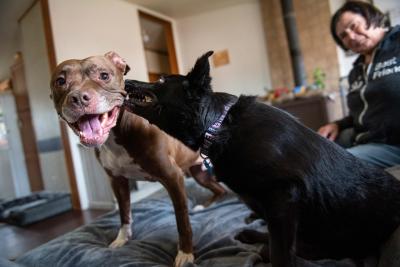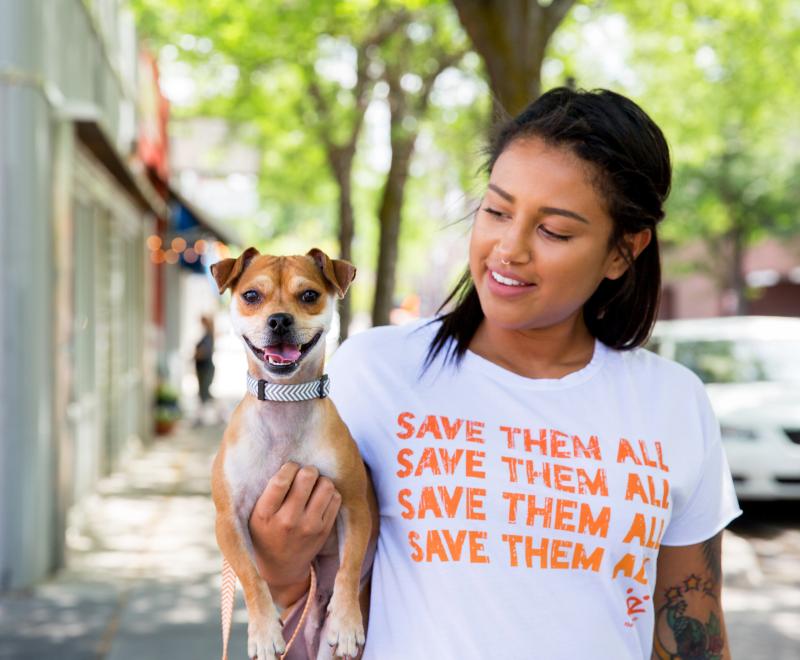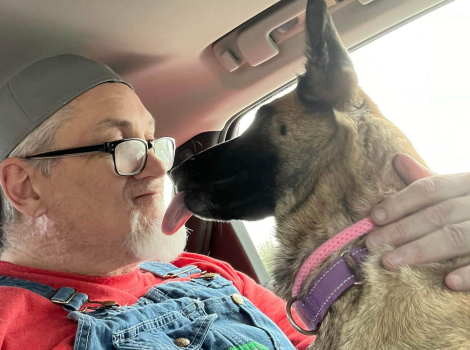Survivor puppy shows big love for life

While Yazh may be small in stature (even her name means “little one” in the Navajo language), her personality is anything but. At 7 months old, she’s chock-full of puppy power, darting and weaving and tumbling and rolling at top speeds during playtime. She loves a good game of tug, and she goes wild for baby talk. Basically, every day is the best day ever for Yazh.
If Yazh could wag her tail, she might just take off into the sky like a helicopter. And at Best Friends Animal Sanctuary, she’s getting some help with her paralyzed hind end, so maybe someday she might. Best Friends’ goal is for all shelters to reach no-kill in 2025, and that means working together with animal welfare organizations to give pets the time and care they need to save more lives.
Helping a paralyzed puppy
Yazh arrived at the Sanctuary with a gunshot wound in her back that had left her hind end paralyzed. There were still pellets inside her. She wasn’t able to stand up fully and could only drag her back legs as she used her front to scoot around. Despite all of that, however, the little puppy was way more interested in all the new people fussing over her. They looked like her new best friends.
The good news was that, despite not being able to use her back legs, Yazh still had some feeling in them. That meant there was a chance she could one day get all four paws under her.

“Initially, we wanted her to have a couple weeks of just rest time to let her body heal from the trauma,” says Monica Kaiser, vet tech at Best Friends Animal Clinic. “And then we started some physical therapy with her.” And though Yazh was quite content to relax (as much as a puppy can relax), she was just as happy for physical therapy to start because it meant being the center of attention. The tasty treats were a bonus.
[Once-paralyzed dog finds her footing with family’s help]
Yazh’s therapy began with electro-acupuncture — acupuncture with the addition of electrical stimulus — to help promote feeling in her hind end. The pup didn’t even blink at the needles; she was so busy enjoying the hands all over her.
Hydrotherapy was next. Three times a week, Yazh’s human friends help her gear up with a little life vest, and she heads for the tank. With guidance on her back paws, Yazh practices walking in water, letting her muscles move through the motions and build up nerve connections.
Finally, Yazh was fitted for a wheeled cart to get her upright and running even smoother and faster than before. Not that she couldn’t catch her human friends already, of course. The cart just makes it easier to play tag.
But a big key to Yazh’s recovery is spending quality time with her foster family.

Finding her footing in a foster home
Moving in with Deb Brown was a big step for Yazh. It’s not only given her a chance to learn about life in a home and how to maneuver around furniture, but also how to interact with other dogs and maneuver those social encounters. Not that Yazh needed much practice there — after a period of just getting used to the home separately, her introduction to Deb’s own dogs went smoothly.
[How to Introduce Dogs to Each Other]
Yazh loves playing with her foster siblings, and they’re gentle with her in turn. When playtime’s over, the whole family is able to relax together just as easily. All the socialization is important for the growing pup; she’s learning how to interact and get along with other dogs. And even when a strange pooch barks at her while she’s out and about, Yazh doesn’t bat an eye.
Being with Deb and her family has added consistency and routine to Yazh’s life, and physical therapy exercises continue at home as well as at the Sanctuary. She’s learning life skills and having fun while she’s at it. “We sort of have a bond through this situation,” Deb says. “And I just want her to be the best she can be.”
Every day, she’s getting that much stronger. And soon, little Yazh and her big personality will be looking forward to the next big step: getting adopted.

Let's make every shelter and every community no-kill by 2025
Our goal at Best Friends is to support all animal shelters in the U.S. in reaching no-kill by 2025. No-kill means saving every dog and cat in a shelter who can be saved, accounting for community safety and good quality of life for pets.
Shelter staff can’t do it alone. Saving animals in shelters is everyone’s responsibility, and it takes support and participation from the community. No-kill is possible when we work together thoughtfully, honestly, and collaboratively.







